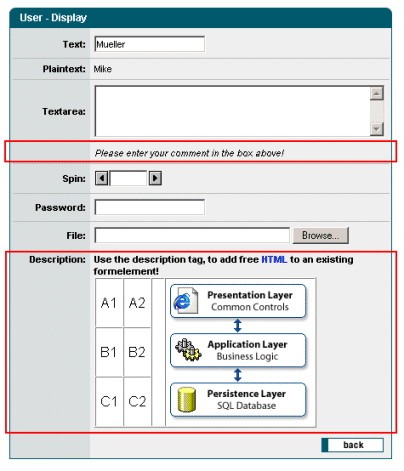| Attribute | Type | Description | Req. | RTExp |
| align | AlignmentType |
Specifies the horizontal alignment of the element.
-
left
=
left alignment
-
right
=
right alignment
-
center
=
center alignment
| |
|
| colspan | Integer |
Specifies the column span of a form element
within a multi column form
| |
|
| description | String |
The description text.
| |
|
| filter | boolean |
The automatic HTML coding of the element can be
activated or disabled with the filter-attribute.
| |
|
| height | String |
Sets the height of the form element. The height
may be specified in absolute or percent terms.
Annotation:
See HTML documentation for the attribute height.
| |
|
| imageref | String |
Pointer to an element of the Imagemap of the form.
The image is drawn before the label of the element.
| |
|
| join | Boolean |
Indicates that two adjacent form elements should be
joined together
| |
|
| label | String |
The label of the form element.
| |
|
| permission | ACL |
With this attribute, access to the element can be restricted.
Authorizations are checked using the com.cc.framework.security.Principal
object in the user session. The principal object is registered in the session
with the method com.cc.framework.security.SecurityUtil#registerPrincipal(HttpSession, Principal).
It is made available by the application developer by implementing the principal
interface. In this manner, any authorization system can be very easily connected
within the framework.
Authorizations are always specified in the form of an Access Control List (ACL).
What is involved here is a semicolon-delimited list with individual authorizations.
The framweork supports the following authorization types, which, however, can be
expanded at will by the application developer:
- Literal
- true|false -> com.cc.framework.security.StaticPermission
- Role
- #rolename -> com.cc.framework.security.RoleBasedPermission
- Function
- $functionname -> com.cc.framework.security.FunctionBasedPermission
| |
|
| valign | AlignmentType |
Specifies the vertical alignment of the element.
-
top
=
top alignment
-
bottom
=
bottom alignment
-
center
=
center alignment
| |
|
| width | String |
Sets the width of the form element. The width
may be specified in absolute or percent terms.
Annotation:
See HTML documentation for the attribute width.
| |
|
